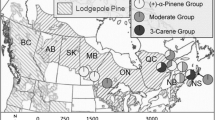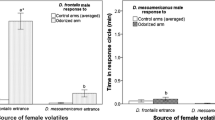Abstract
Predators and parasitoids are known to exploit both plant volatiles and herbivore pheromones to locate their insect prey. However, the interaction of these chemical cues in prey location, and the implications of multiple sources of chemical cues to predator feeding breadth and tracking of herbivore counter adaptations, are less well understood. We evaluated the responses of three coleopteran predators to the pheromones and plant signals associated with two species of common bark beetle prey. Thanasimus dubius, Platysoma cylindrica, and Corticeus parallelus feed exclusively on the fauna within trees colonized by bark beetles. The predominant bark beetles in conifer forests of central Wisconsin are Ips pini and Ips grandicollis. The aggregation pheromone of Wisconsin I. pini contains ipsdienol, which occurs as (+) and (-) enantiomers, and lanierone, and the pheromone of I. grandicollis contains ipsenol. The major hosts of these bark beetles are Pinus resinosa, Pinus banksiana, and Pinus strobus, which contain monoterpenes as their predominant phytochemical volatiles. Monoterpenes by themselves did not attract predators. However, some monoterpenes significantly affected predator attraction to aggregation pheromones. Myrcene, and to a lesser extent 3-carene, reduced predator attraction. By contrast, α-pinene consistently enhanced attraction by all three predators to the pheromones of their Ips prey. However, the predators' responses were modulated by the stereochemistry of α-pinene, and these responses differed when confronted with the different pheromones of the two prey species. (+)-α-Pinene synergized predator responses to the pheromone of I. pini, whereas (-)-α-pinene synergized responses to the pheromone of I. grandicollis. This pattern occurred for all three predator species. Interactions between herbivore pheromones and host plant compounds may provide an important source of behavioral plasticity in predators, and facilitate their ability to track several cryptic species that are distributed across multiple plant species and that show semiochemical variation in space and time.
Similar content being viewed by others
Author information
Authors and Affiliations
Additional information
Electronic Publication
Rights and permissions
About this article
Cite this article
Erbilgin, N., Raffa, K. Modulation of predator attraction to pheromones of two prey species by stereochemistry of plant volatiles. Oecologia 127, 444–453 (2001). https://doi.org/10.1007/s004420000606
Received:
Accepted:
Published:
Issue Date:
DOI: https://doi.org/10.1007/s004420000606




